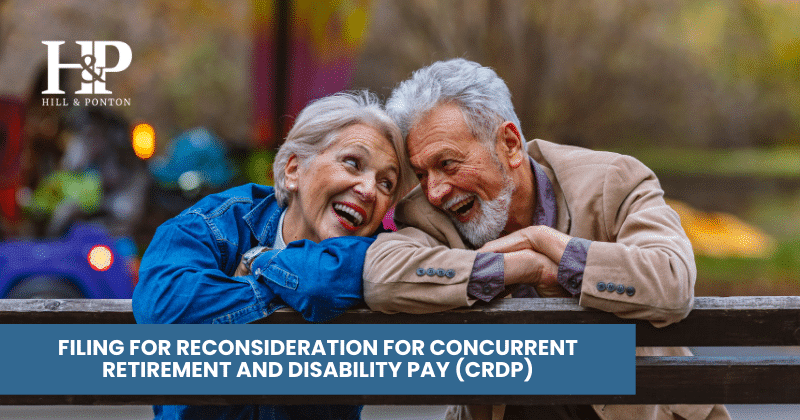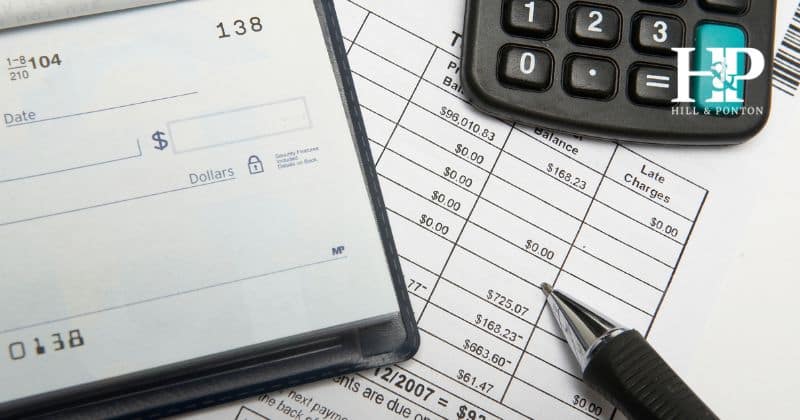CRDP (Concurrent Retirement and Disability Pay) is a program that provides eligible military retirees with both disability compensation from the Department of Veterans Affairs (VA) and retirement pay from the Department of Defense (DoD).
This program allows veterans to receive both types of benefits at the same time, without one offsetting the other.
However, some veterans may believe that they are entitled to a higher CRDP rate based on their individual circumstances.
In this article, we will discuss the eligibility criteria for CRDP , the process of filing a request for reconsideration, and the types of evidence that may be helpful in supporting a reconsideration requisition.
We also will explore common reasons why a veteran may be entitled to a higher CRDP rate, such as the onset of new medical conditions, and provide tips for veterans who are considering filing a reconsideration request.
What is Concurrent Retirement and Disability Pay?
Concurrent Retirement and Disability Pay (CRDP) is a benefit program that allows military retirees to receive both their retirement pay from the Department of Defense (DoD) and their disability compensation from the Department of Veterans Affairs (VA) at the same time.
This program was established in 2004 to help military retirees who have service-related disabilities receive the benefits they deserve without having their retirement pay offset by their disability compensation.
Prior to the establishment of CRDP, military retirees with service-connected disabilities had their retirement pay reduced by the amount of their VA disability compensation.
This was known as the VA disability offset, and it often resulted in a significant reduction in retirement pay for many disabled veterans.
CRDP was created to eliminate this offset and provide veterans with the full retirement pay they have earned, in addition to their disability compensation.
For many veterans, CRDP is an important source of financial support that helps them to make ends meet and support themselves and their families.
Without CRDP, many disabled veterans would struggle to make ends meet, particularly those with significant service-connected disabilities that limit their ability to work or earn an income.
By providing full retirement pay and disability compensation, CRDP ensures that veterans with service-connected disabilities receive the benefits they deserve and need.
CRDP is also important because it helps to ensure that military retirees are not penalized for their service-connected disabilities.
Retiring from the military after years of service is a significant achievement, and veterans who have been injured or disabled while serving their country should not have to choose between their retirement pay and their disability compensation.
By allowing veterans to receive both benefits at the same time, CRDP recognizes the sacrifices that military retirees have made and ensures that they are appropriately compensated for their service.
Overall, CRDP is an important program that provides critical support to disabled military retirees and their families.
By eliminating the VA disability offset and allowing veterans to receive both their retirement pay and disability compensation, CRDP helps to ensure that veterans with service-connected disabilities receive the full range of benefits they have earned through their service to their country.
What are the eligibility requirements for CRDP?
To be eligible for CRDP, a military retiree must meet certain requirements:
Firstly, the retiree must be a military veteran who has served on active duty for a minimum of 20 years.
This includes time spent in the Reserves or National Guard. Retirees who have been medically retired from the military may also be eligible for CRDP.
Secondly, the retiree must have a service-connected disability rated at 50% or higher by the VA.
This means that the VA has determined that the disability is related to the veteran’s military service and is severe enough to warrant compensation.
Retirees with a disability rating below 50% may still be eligible for CRDP if they have a combined rating of 50% or higher when their VA and DoD disability ratings are combined.
Thirdly, the retiree must be receiving VA disability compensation.
This compensation is paid by the VA to veterans who have service-connected disabilities, and it is tax-free.
The amount of compensation depends on the severity of the disability and other factors, such as the number of dependents the veteran has.
Finally, the retiree must have reached their minimum retirement age.
This age varies depending on the year in which the retiree entered military service and the type of retirement plan they are enrolled in.
What is the process of filing a request for reconsideration for CRDP?
If a military retiree believes they are entitled to a higher rate of Concurrent Retirement and Disability Pay (CRDP), they may file a request for reconsideration with the Department of Defense.
Here are the steps involved in filing a request for reconsideration:
- Obtain a copy of your CRDP award letter: The first step is to obtain a copy of your CRDP award letter, which outlines the amount of your retirement pay and disability compensation, as well as any offsets or reductions that may apply. This letter will serve as the basis for your reconsideration request.
- Gather supporting evidence: To support your request for reconsideration, you will need to gather any additional evidence that supports your claim for a higher rate of CRDP. This may include medical records, service records, or other documentation that shows the severity of your service-connected disabilities.
- Write a letter of request: The next step is to write a letter of request for reconsideration. This letter should explain why you believe you are entitled to a higher rate of CRDP, and provide any additional evidence or documentation to support your claim. Be sure to include your name, Social Security number, and contact information in the letter.
- Submit your request: Once you have completed your letter of request and gathered all of the necessary supporting evidence, you can submit your request for reconsideration to the appropriate address or email provided by the DoD.
- Wait for a decision: After your request for reconsideration has been submitted, you will need to wait for a decision from the DoD. The review process may take several weeks or months, depending on the complexity of your case.
- Review the decision: If your request for reconsideration is approved, you will receive a revised CRDP award letter with the new, higher rate of benefits. If your request is denied, you may have the option to appeal the decision through the DoD’s appeal process.
Types of Evidence Helpful in Supporting Reconsideration Requisitions for CRDP
When submitting a request for reconsideration for Concurrent Retirement and Disability Pay (CRDP), it is important to provide strong evidence to support your claim for a higher rate of benefits.
Here are some types of evidence that may be helpful in supporting your reconsideration request:
- Medical records: Medical records can provide evidence of the severity of your service-connected disabilities and the impact they have on your daily life. This may include documentation of doctor’s visits, test results, and treatment plans.
- Service records: Service records can provide evidence of the circumstances surrounding your military service and the events that led to your service-connected disabilities. This may include documentation of deployments, combat injuries, and exposure to hazardous materials.
- Statements from healthcare providers: Statements from your healthcare providers can provide additional support for your claim, as they can attest to the severity of your disabilities and their impact on your ability to work and perform daily activities.
- Social Security disability award letter: If you have received disability benefits from the Social Security Administration (SSA), the award letter can serve as evidence of the severity of your disabilities and your inability to work.
- Testimonials from family and friends: Testimonials from family and friends can provide additional support for your claim, as they can attest to the impact of your disabilities on your daily life and your ability to work.
- Evidence of income loss: If you have experienced a loss of income due to your disabilities, such as being unable to work or having to take a lower-paying job, this can serve as evidence of the financial impact of your disabilities.
Why might a veteran be entitled to a higher rate of CRDP?
There are several common reasons why a veteran may be entitled to a higher rate of Concurrent Retirement and Disability Pay (CRDP).
Here are a few examples:
- Increased disability rating: If a veteran’s disability rating has increased since they first applied for CRDP, they may be entitled to a higher rate of benefits. This may be due to a worsening of their service-connected disabilities, or the addition of new service-connected disabilities.
- Correction of military records: If a veteran’s military records are corrected to reflect a service-connected disability that was not previously recognized, they may be entitled to a higher rate of CRDP. This may occur if a veteran was previously denied disability compensation for a service-connected disability, but the disability is later recognized as related to their military service.
- Retroactive disability benefits: If a veteran is awarded retroactive disability benefits for a service-connected disability, they may be entitled to a higher rate of CRDP. This may occur if a veteran’s disability claim was initially denied, but later approved upon appeal or new evidence.
- Combat-related special compensation: If a veteran is eligible for Combat-Related Special Compensation (CRSC), they may be entitled to a higher rate of CRDP. CRSC provides tax-free compensation to veterans with combat-related disabilities, and may be awarded in addition to CRDP.
- Correction of military retirement pay: If a veteran’s military retirement pay is corrected, they may be entitled to a higher rate of CRDP. This may occur if a veteran’s military retirement pay was calculated incorrectly, resulting in a lower rate of CRDP.
Tips for Veterans Filing a Reconsideration Request for CRDP
If you are a veteran who is considering filing a request for reconsideration for Concurrent Retirement and Disability Pay (CRDP), here are some tips that may be helpful:
- Gather strong evidence: As mentioned earlier, submitting strong evidence is essential in supporting a request for reconsideration for CRDP. Medical records, service records, statements from healthcare providers, Social Security disability award letters, testimonials from family and friends, and evidence of income loss are all examples of evidence that may be helpful in supporting your claim for a higher rate of benefits. Make sure to gather as much relevant evidence as possible to support your claim.
- Understand the reconsideration process: Before filing a request for reconsideration, it is important to understand the process and requirements. The Department of Defense has specific guidelines and deadlines for submitting a request for reconsideration, so make sure to familiarize yourself with these requirements before submitting your request.
- Seek assistance if needed: If you are unsure about the reconsideration process or need help gathering evidence, consider seeking assistance from a Veterans Service Officer (VSO) or other qualified representative. These individuals can provide guidance and support throughout the reconsideration process.
- Be persistent: The reconsideration process can be lengthy and frustrating, but it is important to remain persistent and follow up regularly with the Department of Defense. Keep track of all communications and documentation related to your request for reconsideration, and don’t hesitate to reach out for updates on the status of your claim.
- Consider appealing a denied request: If your request for reconsideration is denied, you may have the option to appeal the decision. This can be a complex process, but with the help of a qualified representative, you may be able to present new evidence or arguments to support your claim.
In conclusion, filing a request for reconsideration for Concurrent Retirement and Disability Pay (CRDP) can be a challenging and complex process for veterans.
However, with the right evidence, knowledge of the process, and persistence, veterans may be able to receive the full range of benefits they are entitled to.
It is important for veterans to gather as much relevant evidence as possible, seek assistance from qualified representatives if needed, understand the requirements of the Department of Defense, and be persistent in following up on the status of their claim.
Even if a request for reconsideration is denied, veterans may have the option to appeal the decision and present new evidence or arguments.
Ultimately, veterans deserve to receive the benefits they have earned through their service, and filing a request for reconsideration for CRDP can be a crucial step in achieving this goal.
Have Questions About Appealing Your Claim or Understanding How the Claims Process Works?
The attorneys at Hill & Ponton are here to support you with appealing a claim to get benefits.
If you are intending to appeal a denied claim, you can contact us for an evaluation and we can help you with this process.
However, if you are considering filing an initial claim, or even if you are interested in learning about the appeals process, we offer a free ebook to get you started on the right foot!
The Road to VA Compensation Benefits will help break down the claims process from start to finish. Click the link below to learn more.





